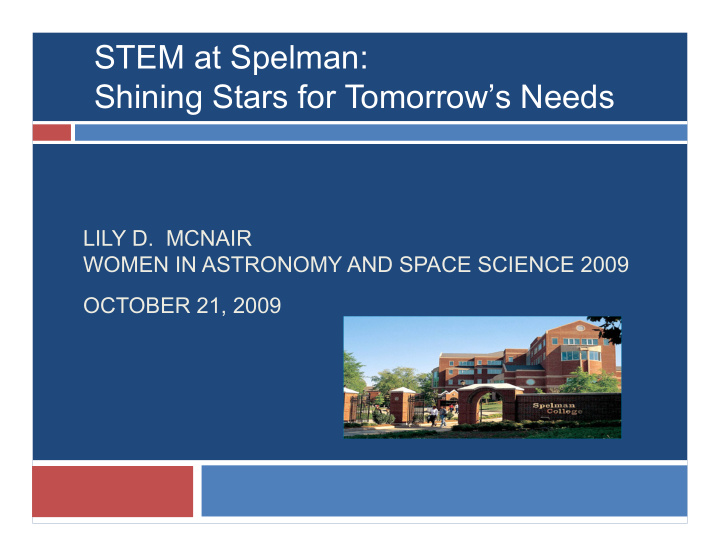



STEM at Spelman: Shining Stars for Tomorrow’s Needs LILY D. MCNAIR WOMEN IN ASTRONOMY AND SPACE SCIENCE 2009 OCTOBER 21, 2009
STEM at Spelman: Shining Stars for Tomorrow’s Needs � � History of STEM at Spelman College � � Significance of STEM success at Spelman � � Institutional Context � � Strategic Initiatives � � Planning for the Future: Role of HBCUs in preparing future scientists
History of STEM at Spelman College � � Biology and Mathematics Departments established prior to 1950 � � Chemistry Department established in 1976 � � Computer and Information Sciences: 1992 � � Physics Department: 2001
Albro-Falconer-Manley Science Center
STEM Majors at Spelman College � � Total College enrollment = 2150 � � STEM majors account for 30% of all majors � � Majority of these majors are in Biology � � One third of all graduates are STEM majors
STEM Majors, 2008-09 STEM Majors, 2008-09 CIS Biology Chemistry Math Physics
Spelman’s Role in Producing African American PhDs in STEM � � Ranked by NSF in 2008 as the #2 undergraduate institution of origin of Black PhDs in STEM � � In 2006, 29.3% of all Black PhDs in STEMs earned their bachelors at HBCUs � � This represents 10.1 Black PhDs per 1,000 bachelors � � For non-HBCUs, 7.9 Black PhDs per 1,000 bachelors
Top 10 bac. origin institutions: 1997-2006 Black STEM PhDs � � 1. Howard University � � 2. Spelman College � � 3. Hampton University � � 4. Florida A & M University � � 5. Morehouse College � � 6. North Carolina A & T University � � 7. Southern University A & M College – Baton Rouge � � 8. Xavier University � � 9. Harvard University � � 10. University of Maryland at College Park Source: NSF, Division of Science Resources Statistics, Survey of Earned Doctorates and National Ctr. For Education Statistics, IPEDs Completion � � Survey, 1977-2006
How did Spelman accomplish this? � � Institutional Vision � � Leadership of Dr. Etta Falconer and Dr. Shirley McBay � � Collaboration of faculty and administrators � � Strategic Planning and Implementation � � Intentional development and growth of the sciences � � Increasing majors in the sciences and mathematics � � Resources � � External funding � � Partnerships and collaborations
Spelman College, 1971 � � 10% of all majors were in the sciences � � 9% of degrees awarded were in the sciences � � Small enrollments in sciences courses beyond the first year level � � Biology and Mathematics were the only departments with majors � � “The science building was dark and uninviting” (Falconer, 1989)
Strategic Planning and Implementation � � Concerted initiatives to increase majors � � Pre-freshman summer programs - recruiting efforts � � Biomedical/Health focus � � Mathematics/CIS/Physical sciences and engineering focus � � Establishment of Health Careers Office � � Office of Science, Engineering, and Technical Careers � � Supplemental instruction and “early warning system,” Math Lab
Cultivating Resources � � NASA: Women in Science and Engineering (WISE) � � NASA: Model Institutions of Excellence � � NIH/NCMHD: Research Infrastructure in Minority Institutions (RIMI) � � NIH/MORE: MBRS-RISE, MARC-U STAR � � NIH/MORE: SCORE � � Howard Hughes Medical Institute
Cultivating Resources � � 2001: Albro-Falconer-Manley Science Center opened � � Collaborations: Georgia Tech, Emory, Georgia State � � Atlanta University Center: Morehouse, Clark Atlanta University, Morehouse School of Medicine � � MOUs: Environmental Protection Agency, Princeton University, Department of Transportation
STEM Research and Training Funding $ 31.3 billion Biology CIS Env Sci Math Physics Psych Chemistry Other
Creating an Environment for Excellence � � “Departmental Culture” (Whitten et al., 2007) � � Culture is “inclusive of women, students of color, and others” � � Tutorial programs (students as tutors) � � Seminar speakers � � Connections with alumnae/mentors � � Informal social activities � � Connections among students in the major
Promoting an Environment of Excellence � � High faculty expectations of student success in the sciences and mathematics � � Small class sizes, 11:1 � � Focus on undergraduate research � � Availability of several research training programs � � Atlanta Univ. Consortium, Ga Tech, Emory, GSU � � Many African American and African American women role models and mentors � � High drive of students
STEM Culture at Spelman College � � Strong cohort of students in sciences and math � � Math, Physics, Chemistry, Biology, CIS clubs, student Environmental Task Force � � SpelBots: competed in three RoboCups; only undergraduate, women, HBCU team to ever qualify � � WISE Scholars, Xerox Scholars, Boeing Scholars � � College-wide annual Research Day � � Support for student travel to research conferences � � Dual Degree in Engineering Program � � STEM represents 95% of all external funding
Culture of Academic Excellence � � Spelman’s mission as the leading HBCU for women of African descent � � Distinctiveness of a woman’s college � � Unique features of a liberal arts college � � Connections among academic excellence and service learning/leadership/community outreach
New Initiatives � � G-STEM: “Enhancing Global Research and Education in STEM at Spelman College;” proposal under review at NSF � � Quality Enhancement Plan for SACS Reaffirmation: � � “Internationalizing the Curriculum” � � Massie Chair in Physics, “The Enhancement of Research, Environmental Management and Science Curriculum,” Department of Energy
Preparing Tomorrow’s Scientists � � Interdisciplinary, collaborative perspectives and experiences � � ASPIRE Project � � ARTSI Project � � Health Disparities Scholars � � Interdisciplinary Curricular collaborations � � Global Experiences � � Teamwork and mentoring
Building on Success for the Future
Recommend
More recommend